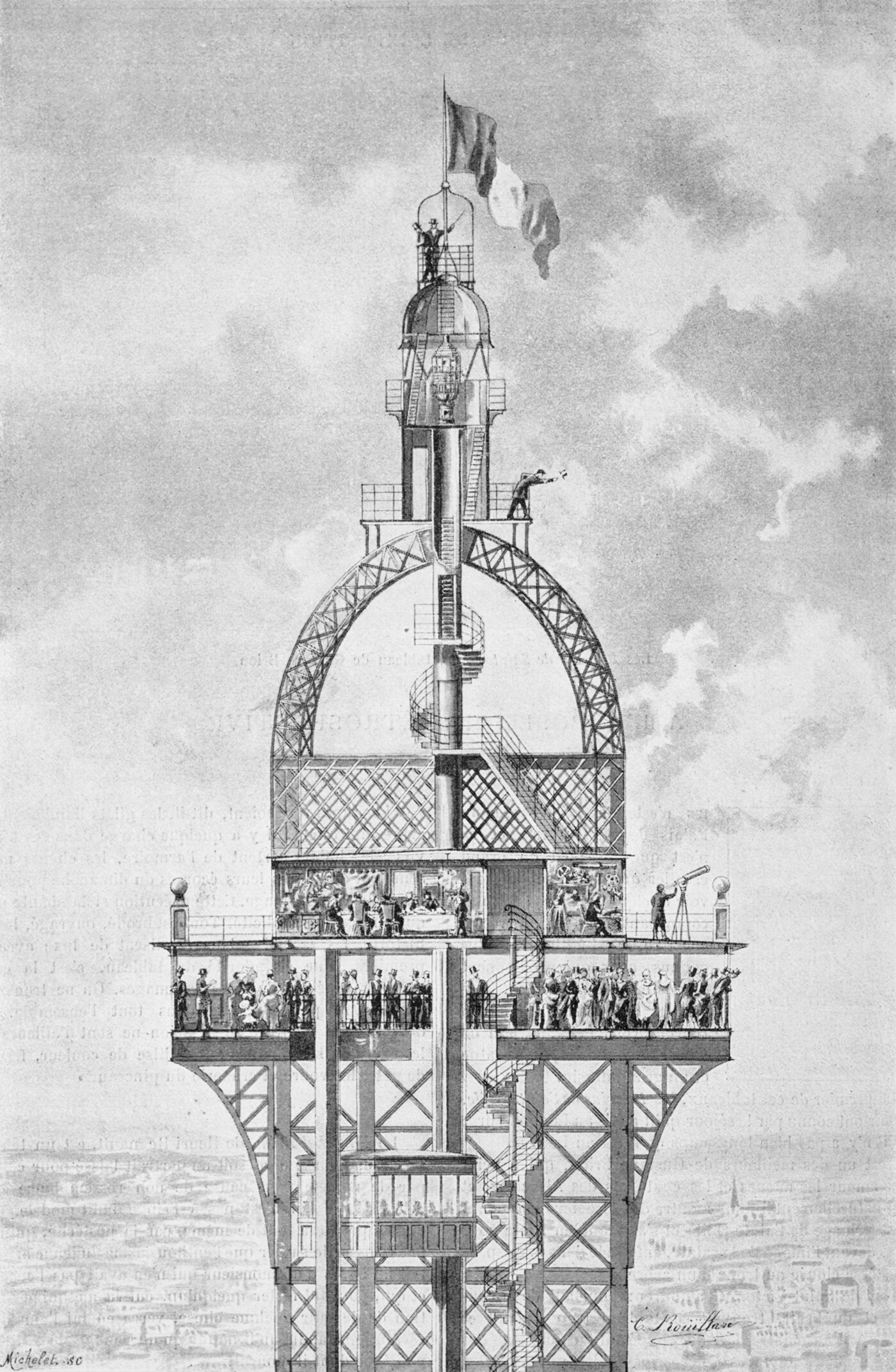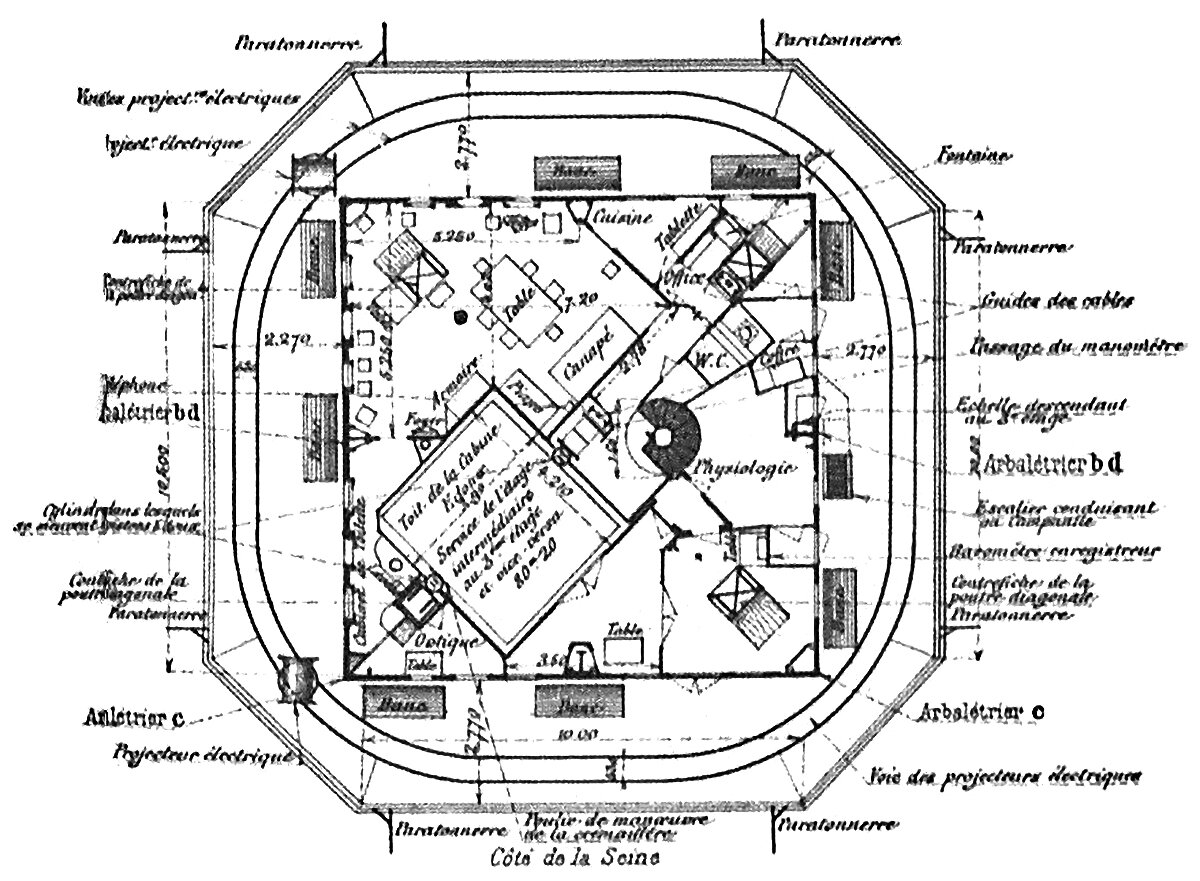The Secret Apartment at the Top of the Eiffel Tower
Illustration from 1889 of the Eiffel Tower’s summit. Originally drawn by M. Rouillard, an engineer that worked with Eiffel on the project. The main observation deck is shown full of visitors, while the level directly above was reserved for a private apartment for Eiffel himself.
Pictured above is an illustration of the Eiffel Tower’s original crown design. You can see the main observation deck, which is packed with people, all enjoying the view atop the tallest building in the world. Unbeknownst to them, however, is the private apartment located on the floor just above them. It was designed by Gustave Eiffel as a private space for himself to entertain notable guests and perform scientific experiments. The apartment was the lowest of a series of platforms that reached the uppermost sections of the tower, which Eiffel used for atmospheric and astronomical experiments. It’s generally referred to as the secret apartment, but it was fairly well-known to the public that Eiffel had this space. It measured roughly 100 square meters (1,075 square feet), and included a workshop, living space, dining room, kitchen, bathroom and piano. It’s referred to as an apartment, but the lack of a bedroom leads most to believe the man never slept there, however.
After word got out that Eiffel had a private abode at the summit of the tower, the space became the envy of the Paris elite. Eiffel received myriad offers to rent out the space for large sums of money, but he refused them all. He only invited select members of the scientific community into the space, the most notable of which was Thomas Edison, who gifted Eiffel a sound recording device.
Historic photograph of Gustave Eiffel’s private apartment atop the Eiffel Tower. The apartment was located directly above the main observation deck, and it was originally kept a secret.
Pictured above is a photograph showing what the original space looked like. It’s fairly traditional and down-to-earth (pun intended), with plush velvet chairs and patterned wallpaper. It’s a cozy and domestic aesthetic, which contrasts sharply with its location and the tower’s wrought-iron latticework. The floor plan, pictured below, shows a rather cramped layout due to the massive columns and elevator shaft that cut through the floor. A small spiral staircase provided the only access, and the entire apartment was surrounded by an outdoor terrace.
Floor plan showing Gustave Eiffel’s private apartment atop the Eiffel Tower. The apartment was located directly above the public observation deck, and was surrounded by an outdoor balcony.
It’s telling that Eiffel located his private apartment directly above the public observation deck. It’s an interesting clash of uses; at one level, you have a space open to the public, which allows individuals to experience the thrill of viewing the city from above. Directly above this is a private residence for a single individual who restricted access to a small group of notable guests from the scientific community. Eiffel was using verticality to assert his dominance over the public, but his motivations for doing so remain unclear.
I’d love to know Why Eiffel restricted his guest list so heavily. He seemed to reserve the space for scientific exploration, and only entertained members of the scientific community there. Perhaps he held science as the pinnacle of human endeavors, and wanted to place it above the needs of society, both metaphorically and physically. Alternatively, he wasn’t born into the upper class of society so perhaps he resented the Paris elite because of this and he wanted to stick it to them by refusing access. Perhaps he was making so much money from the tower that he had no need to rent it out, which allowed him full control to use the space as he saw fit. Whatever the reason, the apartment remains an intriguing curiosity atop the tallest building in the world.
The apartment has since been restored, and visitors to the observation deck can view it through a glass divider, complete with wax mannequins of Eiffel, Edison, and Eiffel’s daughter.
Read about other famous tower crowns throughout history here.



